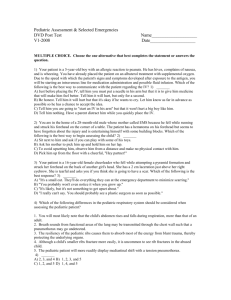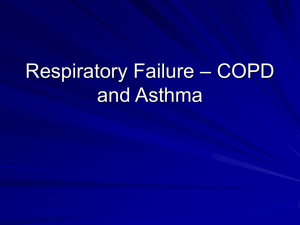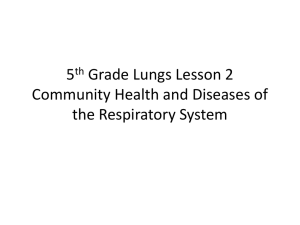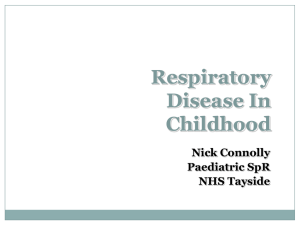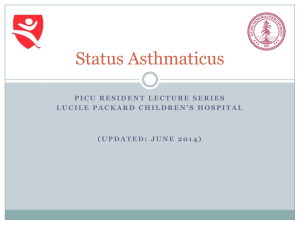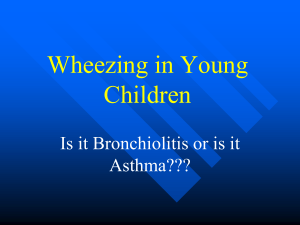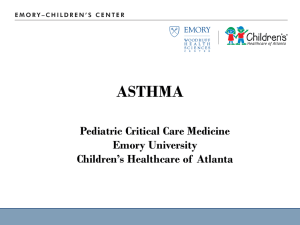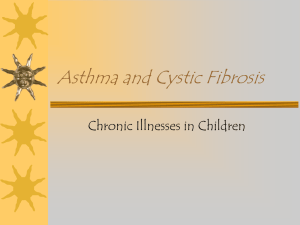Pediatric Respiratory Management
advertisement
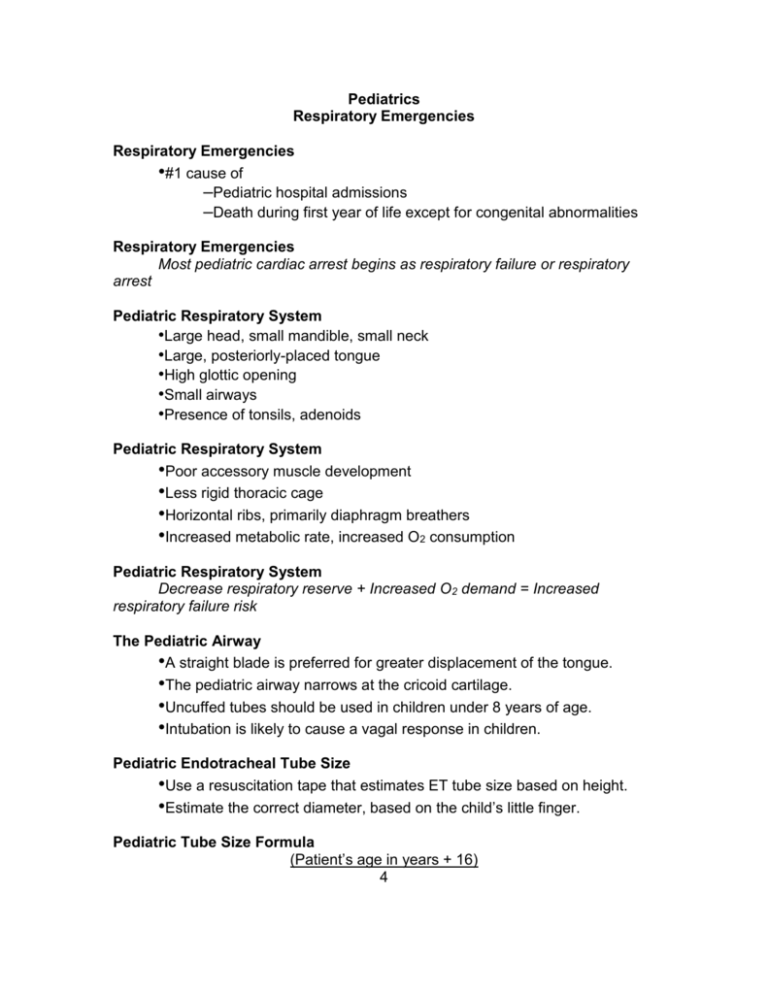
Pediatrics Respiratory Emergencies Respiratory Emergencies •#1 cause of –Pediatric hospital admissions –Death during first year of life except for congenital abnormalities Respiratory Emergencies Most pediatric cardiac arrest begins as respiratory failure or respiratory arrest Pediatric Respiratory System •Large head, small mandible, small neck •Large, posteriorly-placed tongue •High glottic opening •Small airways •Presence of tonsils, adenoids Pediatric Respiratory System •Poor accessory muscle development •Less rigid thoracic cage •Horizontal ribs, primarily diaphragm breathers •Increased metabolic rate, increased O2 consumption Pediatric Respiratory System Decrease respiratory reserve + Increased O2 demand = Increased respiratory failure risk The Pediatric Airway •A straight blade is preferred for greater displacement of the tongue. •The pediatric airway narrows at the cricoid cartilage. •Uncuffed tubes should be used in children under 8 years of age. •Intubation is likely to cause a vagal response in children. Pediatric Endotracheal Tube Size •Use a resuscitation tape that estimates ET tube size based on height. •Estimate the correct diameter, based on the child’s little finger. Pediatric Tube Size Formula (Patient’s age in years + 16) 4 Indications •Need for prolonged artificial ventilation •Inadequate ventilatory support with a BVM •Cardiac or respiratory arrest •Control of an airway in a patient without a cough or gag reflex •Providing a route for drug administration •Access to the airway for suctioning Endotracheal Intubation in the Child - Hyperventilate the child. - Prepare the equipment. - Insert the laryngoscope. - Ventilate and auscultate. - Secure the tube. Reassess tube placement often in the pediatric patient. Confirmation of Tube Placement •Visualization –Tube passing through the vocal cords –Equal rise and fall of the chest –Condensation inside the tube •Auscultation –Lung sounds in the axilla –Absence of sounds over the epigastrium –Lack of phonation (inability to speak) Adjuncts to ETT Confirmation •Esophageal detection devices –May be inaccurate in pediatrics •Undeveloped tracheal rings may allow tracheal collapse to occur. •An uncuffed ET tube will not always create enough tracheal seal, and the device may read falsely positive. •Pulse oximetry –Useful in trending the patient’s oxygenation •Capnography –Preferred method of continuous tube confirmation Respiratory Distress •Tachycardia (May be bradycardia in neonate) •Head bobbing, stridor, prolonged expiration •Abdominal breathing •Grunting--creates CPAP Respiratory Distress Respiratory Emergencies •Croup •Epiglottitis •Asthma •Bronchiolitis •Foreign body aspiration •Bronchopulmonary dysplasia Laryngotracheobronchitis Croup Croup: Pathophysiology •Viral infection (parainfluenza) •Affects larynx, trachea •Subglottic edema; Air flow obstruction Croup: Incidence •6 months to 4 years •Males > Females •Fall, early winter Croup: Signs/Symptoms •“Cold” progressing to hoarseness, cough •Low grade fever •Night-time increase in edema with: –Stridor –“Seal bark” cough –Respiratory distress –Cyanosis •Recurs on several nights Croup: Management •Mild Croup –Reassurance –Moist, cool air Croup: Management •Severe Croup –Humidified high concentration oxygen –Monitor EKG –IV tko if tolerated –Nebulized racemic epinephrine –Consider corticosteroids –Anticipate need to intubate, assist ventilations Epiglottitis: Pathophysiology •Bacterial infection (Hemophilus influenza) •Affects epiglottis, adjacent pharyngeal tissue •Supraglottic edema Epiglottitis: Incidence •Children > 4 years old •Common in ages 4 - 7 •Pedi incidence falling due to HiB vaccination •Can occur in adults, particularly elderly •Incidence in adults is increasing Epiglottitis: Signs/Symptoms •Rapid onset, severe distress in hours •High fever •Intense sore throat, difficulty swallowing •Drooling •Stridor •Sits up, leans forward, extends neck slightly •One-third present unconscious, in shock Epiglottitis Respiratory distress+Sore throat+Drooling = Epiglottitis Epiglottitis: Management •High concentration oxygen •IV tko, if possible •Rapid transport •Do not attempt to visualize airway Epiglottitis - Immediate Life Threat - Possible Complete Airway Obstruction Asthma: Pathophysiology •Lower airway hypersensitivity to: –Allergies –Infection –Irritants –Emotional stress –Cold –Exercise Asthma: Pathophysiology Bronchospasm Bronchial Edema Asthma: Pathophysiology Increased Mucous Production Asthma: Pathophysiology Cast of airway produced by asthmatic mucus plugs Asthma: Signs/Symptoms •Dyspnea •Signs of respiratory distress –Nasal flaring –Tracheal tugging –Accessory muscle use –Suprasternal, intercostal, epigastric retractions Asthma: Signs/Symptoms •Coughing •Expiratory wheezing •Tachypnea •Cyanosis Asthma: Prolonged Attacks •Increase in respiratory water loss •Decreased fluid intake •Dehydration Asthma: History •How long has patient been wheezing? •How much fluid has patient had? •Recent respiratory tract infection? •Medications? When? How much? •Allergies? •Previous hospitalizations? Asthma: Physical Exam •Patient position? •Drowsy or stuporous? •Signs/symptoms of dehydration? •Chest movement? •Quality of breath sounds? Asthma: Risk Assessment •Prior ICU admissions •Prior intubation •>3 emergency department visits in past year •>2 hospital admissions in past year •>1 bronchodilator canister used in past month •Use of bronchodilators > every 4 hours •Chronic use of steroids •Progressive symptoms in spite of aggressive Rx Asthma Silent Chest equals Danger Golden Rule All that wheezes is not asthma!!! •Pulmonary edema •Allergic reactions •Pneumonia •Foreign body aspiration Asthma: Management •Airway •Breathing –Sitting position –Humidified O2 by NRB mask •Dry O2 dries mucus, worsens plugs –Encourage coughing –Consider intubation, assisted ventilation Asthma: Management •Circulation –IV TKO –Assess for dehydration –Titrate fluid administration to severity of dehydration –Monitor ECG Asthma: Management •Obtain medication history –Overdose –Arrhythmias Asthma: Management •Nebulized Beta-2 agents –Albuterol –Terbutaline –Metaproterenol –Isoetharine Asthma: Management •Nebulized anticholinergics –Atropine –Ipatropium •IV / IM Corticosteroids –Solu-Medrol –Decadron Asthma: Management •Subcutaneous beta agents –Epinephrine 1:1000--0.1 to 0.3 mg SQ –Terbutaline--0.25 mg SQ Asthma: Management •Use EXTREME caution in giving two sympathomimetics to same patient •Monitor ECG Asthma: Management •Avoid –Sedatives •Depress respiratory drive –Antihistamines •Decrease LOC, dry secretions –Aspirin •High incidence of allergy Status Asthmaticus Asthma attack unresponsive to -2 adrenergic agents Status Asthmaticus •Humidified oxygen •Rehydration •Continuous nebulized beta-2 agents •Atrovent •Corticosteroids •Aminophylline (controversial) •Magnesium sulfate (controversial) Status Asthmaticus •Intubation •Mechanical ventilation –Large tidal volumes (18-24 ml/kg) –Long expiratory times •Intravenous Terbutaline –Continuous infusion –3 to 6 mcg/kg/min Bronchiolitis: Pathophysiology •Viral infection (RSV) •Inflammatory bronchiolar edema •Air trapping Bronchiolitis: Incidence •Children < 2 years old •80% of patients < 1 year old •Epidemics January through May Bronchiolitis: Signs/Symptoms •Infant < 1 year old •Recent upper respiratory infection exposure •Gradual onset of respiratory distress •Expiratory wheezing •Extreme tachypnea (60 - 100+/min) •Cyanosis Asthma vs Bronchiolitis •Asthma –Age - > 2 years –Fever - usually normal –Family Hx - positive –Hx of allergies - positive –Response to Epi - positive •Bronchiolitis –Age - < 2 years –Fever - positive –Family Hx - negative –Hx of allergies - negative –Response to Epi – negative Bronchiolitis: Management •Humidified oxygen by NRB mask •Monitor EKG •IV tko •Anticipate order for bronchodilators •Anticipate need to intubate, assist ventilations Foreign Body Airway Obstruction FBAO FBAO: High Risk Groups •> 90% of deaths: children < 5 years old •65% of deaths: infants FBAO: Signs/Symptoms •Suspect in any previously well, afebrile child with sudden onset of: –Respiratory distress –Choking –Coughing –Stridor –Wheezing FBAO: Management •Minimize intervention if child conscious, maintaining own airway •100% oxygen as tolerated •No blind sweeps of oral cavity •Wheezing –Object in small airway –Avoid trying to dislodge in field FBAO: Management •Inadequate ventilation –Infant: 5 back blows/5 chest thrusts –Child: Abdominal thrusts –Consider direct visualization with McGill’s if intubation is required Bronchopulmonary Dysplasia BPD BPD: Pathophysiology •Complication of infant respiratory distress syndrome •Seen in premature infants •Results from prolonged exposure to high concentration O2 , mechanical ventilation BPD: Signs/Symptoms •Require supplemental O2 to prevent cyanosis •Chronic respiratory distress •Retractions •Rales •Wheezing •Possible cor pulmonale with peripheral edema BPD: Prognosis •Medically fragile, decompensate quickly •Prone to recurrent respiratory infections •About 2/3 gradually recover BPD: Treatment •Supplemental O2 •Assisted ventilations, as needed •Diuretic therapy, as needed
